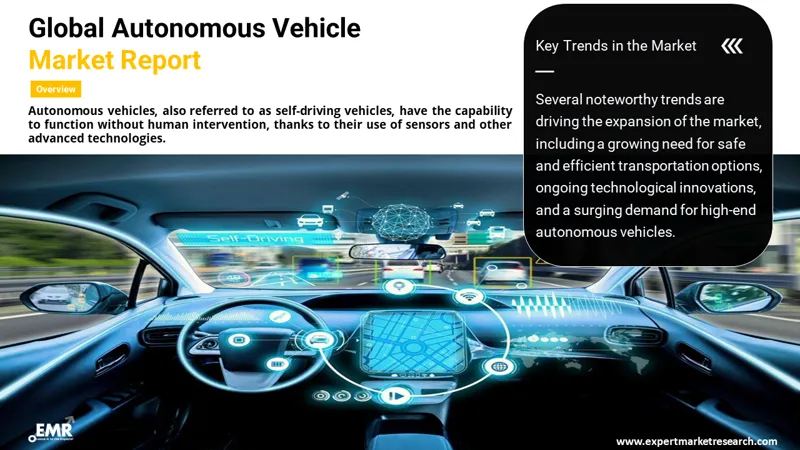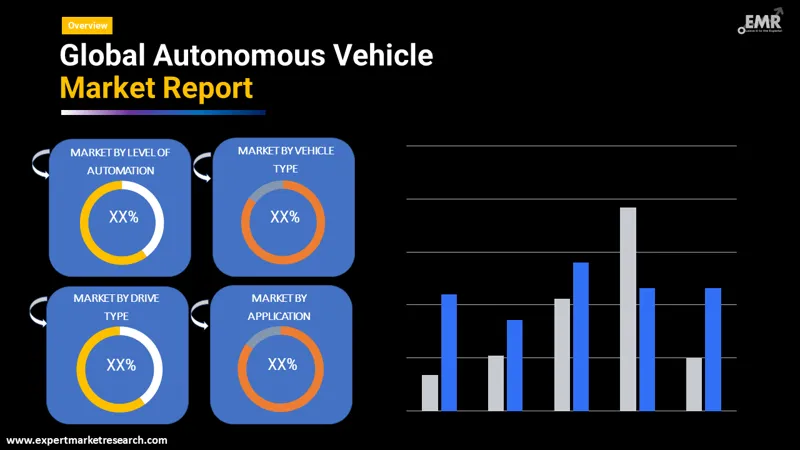
Consumer Insights
Uncover trends and behaviors shaping consumer choices today
Procurement Insights
Optimize your sourcing strategy with key market data
Industry Stats
Stay ahead with the latest trends and market analysis.
The global autonomous vehicles market size reached a value of approximately USD 152.14 Billion in 2025. The market is further expected to grow at a CAGR of 27.70% between 2026 and 2035, reaching a value of USD 1754.50 Billion by 2035.
Base Year
Historical Period
Forecast Period
Compound Annual Growth Rate
27.7%
Value in USD Billion
2026-2035
*this image is indicative*
| Global Autonomous Vehicles Market Report Summary | Description | Value |
| Base Year | USD Billion | 2025 |
| Historical Period | USD Billion | 2019-2025 |
| Forecast Period | USD Billion | 2026-2035 |
| Market Size 2025 | USD Billion | 152.14 |
| Market Size 2035 | USD Billion | 1754.50 |
| CAGR 2019-2025 | Percentage | XX% |
| CAGR 2026-2035 | Percentage | 27.70% |
| CAGR 2026-2035 - Market by Region | Asia Pacific | 31.9% |
| CAGR 2026-2035 - Market by Country | India | 33.5% |
| CAGR 2026-2035 - Market by Country | China | 30.6% |
| CAGR 2026-2035 - Market by Level of Automation | Level 3 | 31.3% |
| CAGR 2026-2035 - Market by Vehicle Type | Passenger Car | 30.5% |
| Market Share by Country 2025 | Japan | 4.3% |
Autonomous vehicles, also known as driverless vehicles, are vehicles that can operate without any human intervention. Sensors and other devices aid in detecting and responding to external surroundings and conditions to avoid accidents. Autonomous vehicles are considered to have superior safety features as compared to human-driven vehicles as they minimise fatigue and human errors.

Read more about this report - REQUEST FREE SAMPLE COPY IN PDF
The EMR’s report titled “Autonomous Vehicles Market Report and Forecast 2026-2035 offers a detailed analysis of the market based on the following segments:
Market Breakup by Level of Automation
Market Breakup by Application
Market Breakup by Drive Type
Market Breakup by Vehicle Type
Market Breakup by Region

Read more about this report - REQUEST FREE SAMPLE COPY IN PDF
Level 3 automation accounts for a significant share of the market due to their advanced decision making and environment and threat detection capabilities, while also supporting manual takeover as needed. Level 3, also known as conditional driving automation, employs various artificial intelligence tools and driver assistance systems that aid in altering the path of the vehicle depending upon driving situation and traffic around the vehicle. Incorporation of traffic jam assistance technology in level 3 automotive vehicles are also expected to boost the demand for level 3 automation.
On the basis of region, North America accounts for a major share of the autonomous vehicle market owing to the growing popularity of driverless cars in the region. Launch of new products by key players in the region with enhanced features to improve the quality of the drive along with increased safety features are also aiding the growth of the regional market. According to the, growing initiatives taken by the governments in North America for autonomous vehicles are also fuelling the growth of the market in the region. Advancements in automated transportation technologies due to increasing research and development activities are further propelling autonomous vehicle market growth in North America.
| CAGR 2026-2035 - Market by | Country |
| India | 33.5% |
| China | 30.6% |
| UK | 25.3% |
| USA | 24.7% |
| Germany | 22.8% |
| Canada | XX% |
| France | XX% |
| Italy | XX% |
| Japan | 19.1% |
| Australia | XX% |
| Saudi Arabia | XX% |
| Brazil | XX% |
| Mexico | XX% |
The comprehensive EMR report provides an in-depth assessment of the market based on the Porter's five forces model along with giving a SWOT analysis. The report gives a detailed analysis of the following key players in the global autonomous vehicle market, covering their competitive landscape and latest developments like mergers, acquisitions, investments, and expansion plans.
Tesla, Inc. is a multinational automotive company that was founded in 2003 and is based in Texas, United States. Their mission is to expedite the adoption of sustainable energy in order to reduce the reliance on fossil fuels and achieve a zero-emission future. Tesla manufactures a range of popular electric cars and also offers solar roofs, solar panels, power walls, and insurance.
General Motors is an automotive manufacturing company that was established in 1908 and is headquartered in Michigan, United States. One of the largest automakers across the globe, General Motors focuses on electrification, vehicle safety, and social impact, with a vision for autonomous vehicles. Some of the major brands of General Motors include Buick, Cadillac, Chevrolet, and GMC.
Bayerische Motoren Werke AG is a leading luxury vehicle company that was founded in 1916 and is based in Munich, Germany. With over 30 production sites, the company has a sales network spanning over 140 countries. Apart from manufacturing motorcycles and automobiles, they also provide premium mobility and financial services.
*Please note that this is only a partial list; the complete list of key players is available in the full report. Additionally, the list of key players can be customized to better suit your needs.*
Other market players include Toyota Motor Corporation, The Mercedes-Benz Group AG, Ford Motor Company, Zoox, Inc., Volkswagen AG, and Groupe Renault, among others.




*While we strive to always give you current and accurate information, the numbers depicted on the website are indicative and may differ from the actual numbers in the main report. At Expert Market Research, we aim to bring you the latest insights and trends in the market. Using our analyses and forecasts, stakeholders can understand the market dynamics, navigate challenges, and capitalize on opportunities to make data-driven strategic decisions.*
Get in touch with us for a customized solution tailored to your unique requirements and save upto 35%!
The market size for autonomous vehicles reached a value of approximately USD 152.14 Billion in 2025.
The market for autonomous vehicles is expected to grow at a CAGR of 27.70% between 2026 and 2035.
The market for autonomous vehicles is estimated to witness a healthy growth in the forecast period of 2026-2035 to reach USD 1754.50 Billion by 2035.
According to major drivers of the market include increasing consumer preference for autonomous vehicles and rising advancements in automotive technology.
The key trends fuelling the growth of the market include rising requirement for efficient and safe modes of transportation, technological advancements, and increasing demand for luxury autonomous vehicles.
The significant applications in the market are civil, defence, transportation and logistics, and construction.
The objectives of autonomous vehicle include identification of acceleration to apply on a given path, avoidance of obstacles that come in the way, and general adherence to safe driving protocols.
The various vehicle types in the market are passenger car and commercial vehicle.
The major regions in the market are North America, Europe, the Asia Pacific, Latin America, and the Middle East and Africa.
The key players in the global autonomous vehicles market are Tesla, Inc., General Motors, Bayerische Motoren Werke AG, Toyota Motor Corporation, The Mercedes-Benz Group AG, Ford Motor Company, Zoox, Inc., Volkswagen AG, and Groupe Renault, among others.
Explore our key highlights of the report and gain a concise overview of key findings, trends, and actionable insights that will empower your strategic decisions.
| REPORT FEATURES | DETAILS |
| Base Year | 2025 |
| Historical Period | 2019-2025 |
| Forecast Period | 2026-2035 |
| Scope of the Report |
Historical and Forecast Trends, Industry Drivers and Constraints, Historical and Forecast Market Analysis by Segment:
|
| Breakup by Level of Automation |
|
| Breakup by Application |
|
| Breakup by Drive Type |
|
| Breakup by Vehicle Type |
|
| Breakup by Region |
|
| Market Dynamics |
|
| Competitive Landscape |
|
| Companies Covered |
|
Datasheet
One User
USD 2,499
USD 2,249
tax inclusive*
Single User License
One User
USD 3,999
USD 3,599
tax inclusive*
Five User License
Five User
USD 4,999
USD 4,249
tax inclusive*
Corporate License
Unlimited Users
USD 5,999
USD 5,099
tax inclusive*
*Please note that the prices mentioned below are starting prices for each bundle type. Kindly contact our team for further details.*
Flash Bundle
Small Business Bundle
Growth Bundle
Enterprise Bundle
*Please note that the prices mentioned below are starting prices for each bundle type. Kindly contact our team for further details.*
Flash Bundle
Number of Reports: 3
20%
tax inclusive*
Small Business Bundle
Number of Reports: 5
25%
tax inclusive*
Growth Bundle
Number of Reports: 8
30%
tax inclusive*
Enterprise Bundle
Number of Reports: 10
35%
tax inclusive*
How To Order

Select License Type
Choose the right license for your needs and access rights.

Click on ‘Buy Now’
Add the report to your cart with one click and proceed to register.

Select Mode of Payment
Choose a payment option for a secure checkout. You will be redirected accordingly.
Gain insights to stay ahead and seize opportunities.

Get insights & trends for a competitive edge.

Track prices with detailed trend reports.

Analyse trade data for supply chain insights.

Leverage cost reports for smart savings

Enhance supply chain with partnerships.

Connect For More Information
Our expert team of analysts will offer full support and resolve any queries regarding the report, before and after the purchase.
Our expert team of analysts will offer full support and resolve any queries regarding the report, before and after the purchase.
We employ meticulous research methods, blending advanced analytics and expert insights to deliver accurate, actionable industry intelligence, staying ahead of competitors.
Our skilled analysts offer unparalleled competitive advantage with detailed insights on current and emerging markets, ensuring your strategic edge.
We offer an in-depth yet simplified presentation of industry insights and analysis to meet your specific requirements effectively.
Share